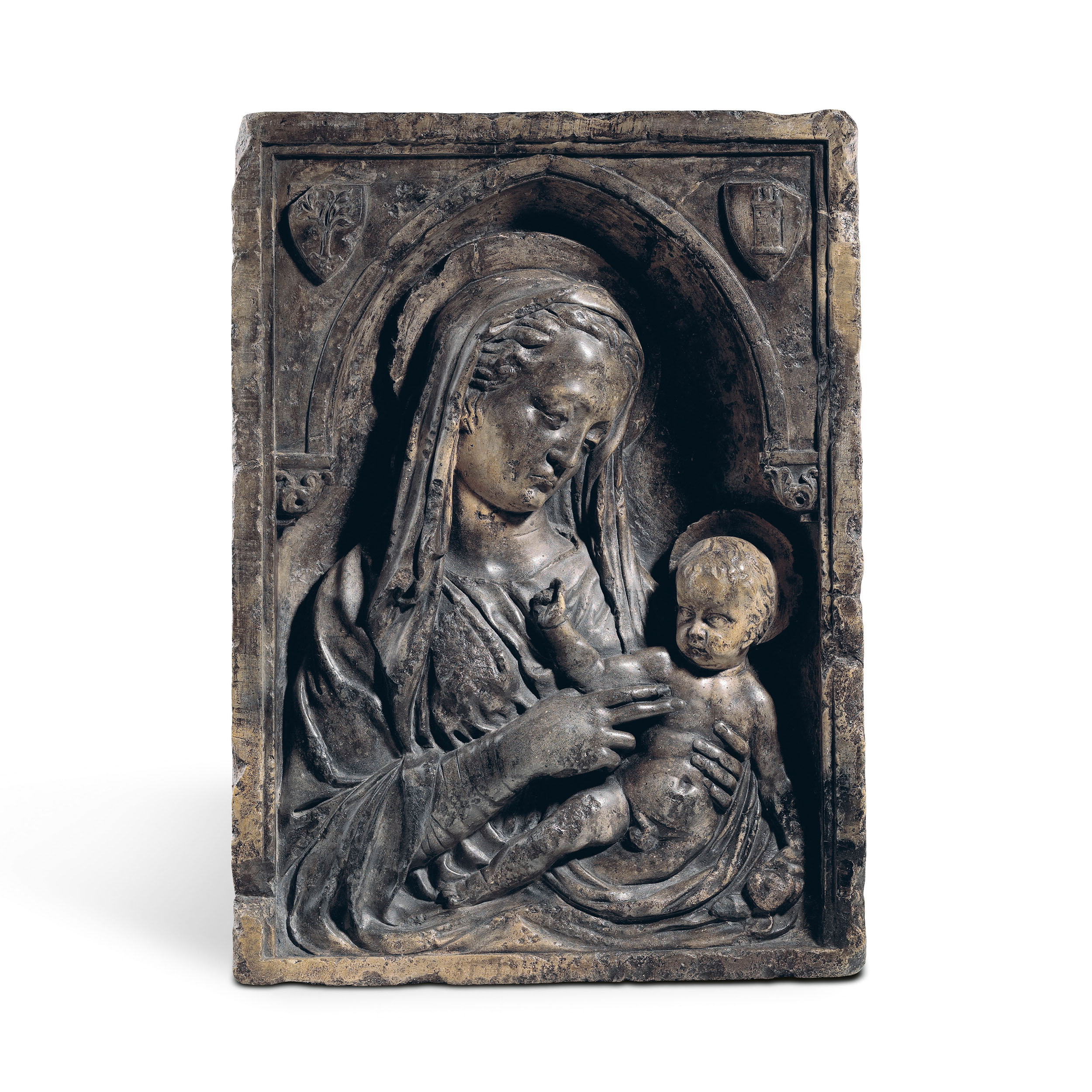aux armoiries de DELLA ROVERE
Italie, Florence, XVe siècle
Pietra arenaria
Hauteur 64 cm
Dans un panneau rectangulaire est sculpté en bas-relief la Vierge
présentée de trois-quarts regarde avec une douce mélancolie
l’enfant Jésus qu’elle tient dans ses mains.
Ce dernier est présenté de face, sa tête tourné vers sa mère,
le regard est davantage dirigé au loin, déjà engagé vers son destin,
conscient de ce qui l’attend. Dans sa main gauche il tient une pomme.
Le groupe est placé dans une structure sous arcade. Sur les côtés,
dans chaque écoinçons des armoiries - sur celle de droite un chêne,
sur celle de gauche une tour de château.
Ces armoiries appartiennent à la noble famille italienne de Della Rovere. L’appellation latine du chêne, « quercus petraea » se dit en italien quercia rovere.
L’association du chêne et du château est propre à un membre particulier de la famille Rovere - Girolamo Basso della Rovere (1434-
1507). Neveu du pape Sixte IV, qui le fait cardinal en 1477. Basso
est un ami des arts et des lettres et permet l’aboutissement de la
construction de la basilique de Loreto commencée par le pape Paul II.
Sa tombe construite par Sansovino présente des armoiries similaires
(fig.1) à celle de notre panneau.
Ce type de panneau en relief selon la mode et l’usage de l’époque ,
servait de support à la dévotion privée dans l’intimité des demeures
italiennes. Dans ce contexte, il serait acceptable de penser que la
pomme que tient l’Enfant Jésus, soit une pomme de chêne, et donc
un écho à l’armoirie familiale.
MADONNA WITH CHILD WITH DELLA ROVERE COAT OF ARMS
Florence, 15th century
Pietra arenaria
H. 64 cm
In a rectangular panel carved in low-relief, the Virgin, presented
in three quarters, with a gentle melancholy look at the Child,
holding him in her hands.
The body of the Child is presented facing front, his head turned
towards his mother, however the gaze is distant, already committed
to his destiny, aware of what awaits him.
In his left hand he holds an apple. The group is placed in an
arched structure. On the sides, in each spandrel, coat of arms - on
the right one an oak, on the left a castle tower.
These coats of arms belong to the noble Italian family of Della Rovere.
The latin name for oak, quercus petraea, in italian means quercia
o rovere. The association of oak and castle is unique to a particular member of the Rovere family — Girolamo Basso della Rovere (1434-1507). Nephew of Pope Sixtus IV, who made him cardinal in 1477.
Basso is a friend of the arts and letters and allows the completion
of the construction of the Basilica of Loreto begun by Pope Paul II.
His tomb built by Sansovino has a similar coat of arms (fig. 1) to
that of our panel. This type of relief panel, according to the fashion and custom of the time, served as a support for private devotion in the privacy of Italian homes. In this context, it would be acceptable to think
that the apple that the Child Jesus is holding is an oak apple, and
therefore an echo of the family coat of arms.
Description complète







